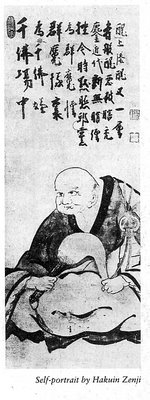Religions Arehttp://www2.blogger.com/img/gl.link.gif Like Peaches - They Don't Travel Well
Where religions go haywire is when the people of one watershed go over the hill to the next one and insist that the other folks take on their belief system. Sort of as if one of our commune went to the commune next door and insisted that everyone there agree that the Zen Trail was the best trail in the universe. But next door had their own local tree and water spirits, rock trolls and fairies. So it's irrational to try to put the our belief system over theirs. I guess what I'm saying is that I view religion as intimately tied up with watershed. Christianity would have been fine if it had stayed as Nazarenism or Galilee-ism, and Judaism as -- well, wherever it began -- Judah, I guess. May a million religions bloom!
Of course overarching beliefs, like the Golden Rule, would be found to be common to all. Yes? Maybe even the original set of commandments given to Noah? Noah-ism is still viewed as an early 'covenant' religion, by the way, with the rainbow the sign of God's contract (hm...).
Above all the local belief structures - and I would include amongst these knowing the personal names of your individual trees and rocks and springs - you move into "spirituality," which is a whole other thing that has nothing to do with communal watershed practices and all to do with the individual's personal experience of the cosmos.
Another group that I admire very much is the Santal tribe of India. Here's a brief description from the book titled "The hill of flutes: Life, love, and poetry in tribal India: a portrait of the Santals," by W. G. Archer, that describes them in detail (and remains one of my favorite books). Out of print by available used on www.campusi.com for around $9.
"The Santals with their cheerful disposition and love for hunting, singing and dancing, lead freer, less inhibited lives than do Hindu and Muslim cultivators. They speak their own pre-Dravidian language of Santali, worship their own Santal bongas or spirits, regulate their village life in a democratic manner and celebrate their own Santal festivals with dancing and feasting. (Archer 1977:15)
Continuing from a Google quote:
The Santals, the largest tribal community on the Indian Subcontinent, numbers approximately 5 million people. They are scattered throughout north India as well as in Nepal and Bangladesh. In India the Santals are found mainly in the states of Bihar, West Bengal, Orissa and Assam. Santals speak Santali which belongs to the Munda group of languages of the Austro-Asiatic language family (Gautam 1998:14). The Santals prefer to call themselves hor (Santali; human being. A common term in all Mundari languages) or adivasi (sanskrit; original settler).
An Archer quote regarding an earlier sociologist who put a Santal dictionary together: "Bodding`s reference to the Santals chief spirit, Maran Buru, as 'the devil' and his description of Santal poetry as 'often pure gibberish' were later to outrage me but his huge Santali-English dictionary staggered me by its encyclopaedic learning and gave me indispensable help. (Archer 1974:11) "
No doubt by now the Santals have been converted to some form of Christianity and their culture destroyed. The same has happened to various other tribes found on the Indian subcontinent that also formed various very interesting cultures, such as the Muria tribe that developed the tradition of the children's center or 'ghotul,' where kids had their own subculture from the age of 5 or so. The main source for information on this group is "The Kingdom of the Young" by one of my heroes, Verrier Elwin, an English missionary who went to India to convert the heathen. He took one look at the Muria culture and said, "Heck, they've got it more together than we do!" So he married a native woman and spent the rest of his life studying and writing about their way of life. Click here for an essy on Elwin I put together.
Also here's a quote that came up on Google from what seems to be a documentary on the Muria tribe:
[quote] THE MURIA
30 minutes Colour 1982 Film-maker: Chris Curling
The Muria of Central India live in a forested area encircled by mountains. Their relative isolation has allowed them some differences from the rest of India, in particular their lack of caste. Their land is protected by the government, each family is ideally self-sufficient, and marriage, which unites the four clans of the Muria, is seen as the basis of social order.
The focus of this film, like the ethnographies of V. Elwin (1947) and S. Mansingh Gell (1984), is on the institution of the ghotul in Muria society. The ghotul is a dormitory within the village where all people from about the age of twelve until their marriage must stay. The ghotul is governed by the young people, cared for by them, and in many ways is a society of youth within the larger society of Muria village life. The years of the ghotul are seen as a time for freedom and exploration, as a preparation for adult life. An aspect of the ghotul which captured the Western imagination is its relation to the trinity of sex, love, and marriage. Elwin's original ethnography, of which abridged versions are available in French, Italian, and English, portrayed ghotul life in a way that continues to embarrass the Indian government as well as raising ethical questions about the anthropologist's use of public and private information. The anthropological advisor for the film, S. Mansingh Gell, asked that her name be removed from the credits because, in her opinion, the final version of the film does little to correct the sort of stereotype found in Elwin's study.
Despite these problems, The Muria is an interesting and informative film that does try to explain the ghotul and its relevance to Muria society. The ghotul is in some ways opposed to the rest of the society. During her ghotul years, a girl has a choice of partner, while afterwards her bridal partner is chosen by others. During ghotul years, the young have more money, more friends, and more freedom than they will have again in their lives. All this creates a deep nostalgia for the ghotul; young and old alike remember their ghotul years as the happiest of their lives.
[End Quote]
It makes me want to order the movie!!! But Elwin's book is available and a fascinating read. It was boiled down from a much larger manuscript that I also have as a photocopy.
I developed the concept of futuristic youth centers for our culture that I named "Go-too's," which I wrote about in some detail in various (unpublished) novels. More about that another time.
Labels: aborigines, children's communities, elves, fairies, ghotul, Muria, religion, Santal, sprites, trolls, watershed


